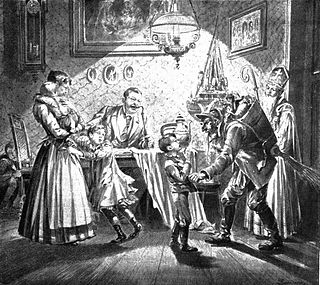 W
WIn English-speaking cultures, a Christmas elf is a diminutive elf that lives with Santa Claus at the North Pole and acts as his helper. Christmas elves are usually depicted as green- or red-clad, with large, pointy ears and wearing pointy hats. They are most often depicted as humanoids, but sometimes as furry mammals with tails. Santa's elves are often said to make the toys in Santa's workshop and take care of his reindeer, among other tasks.
 W
WThe companions of Saint Nicholas are a group of closely related figures who accompany Saint Nicholas throughout the territories formerly in the Holy Roman Empire or the countries that it influenced culturally. These characters act as a foil to the benevolent Christmas gift-bringer, threatening to thrash or abduct disobedient children. Jacob Grimm associated this character with the pre-Christian house spirit which could be benevolent or malicious, but whose mischievous side was emphasized after Christianization. The association of the Christmas gift-bringer with elves has parallels in English and Scandinavian folklore, and is ultimately and remotely connected to the Christmas elf in modern American folklore.
 W
WKnecht Ruprecht is a companion of Saint Nicholas as described in the folklore of Germany. He first appears in written sources in the 17th century, as a figure in a Nuremberg Christmas procession.
 W
WKrampus is a horned, anthropomorphic figure in Alpine folklore who during the Christmas season scares children who have misbehaved, assisting Saint Nicholas. The pair visit children on the night of the 5th December and Saint Nicholas rewards the well-behaved children with modest gifts such as oranges, dried fruit, walnuts and chocolate whilst the badly behaved ones only receive punishment with birch rods.
 W
WMr. Bingle is a fictional character, a snowman assistant to Santa Claus. The figure consisted of a snowman's body with an ice cream cone hat, candy cane in hand, red ribbon with bells and holly wings. Originating as a mascot of the Maison Blanche department store in New Orleans, Louisiana, the character was later marketed in New Orleans and elsewhere by Mercantile Stores and Dillard's, and it remains part of the popular culture of the Greater New Orleans area.
 W
WMrs. Claus is the mythical wife of Santa Claus, the Christmas gift-bringer in Western Christmas tradition. She is known for making cookies with the elves, caring for the reindeer, and preparing toys with her husband.
 W
WOlive, the Other Reindeer is a 1999 American 2D computer-animated Christmas comedy musical film written by Steve Young, based on the children's book by J. Otto Seibold, and directed by Academy Award-nominated animator Steve Moore. The feature was produced by Matt Groening's The Curiosity Company and animated by DNA Productions. It first aired on December 17, 1999 alongside Futurama on Fox, ten years after the premiere date of Groening's television series The Simpsons. Produced by 20th Century Fox Television and Flower Films.
 W
WAccording to traditional festive legend in some parts of the world, Santa Claus's reindeer are said to pull a sleigh through the night sky to help Santa Claus deliver gifts to children on Christmas Eve. The commonly cited names of the nine reindeer are Dasher, Dancer, Prancer, Vixen, Comet, Cupid, Donner, Blitzen, and Rudolph, although Donner is sometimes called Donder and Blitzen is sometimes called Blixem.
 W
WRudolph the Red-Nosed Reindeer is a fictional reindeer created by Robert Lewis May. Rudolph is usually depicted as the ninth and youngest of Santa Claus's reindeer, using his luminous red nose to lead the reindeer team and guide Santa's sleigh on Christmas Eve. Though he initially receives ridicule for his nose as a fawn, the brightness of his nose is so powerful that it illuminates the team's path through harsh winter weather. Ronald D. Lankford, Jr., described Rudolph's story as "the fantasy story made to order for American children: each child has the need to express and receive approval for his or her individuality and/or special qualities. Rudolph's story embodies the American Dream for the child, written large because of the cultural significance of Christmas."
 W
W"Santaland Diaries" is an essay by David Sedaris. It is a humorous account of Sedaris' stint working as a Christmas elf in "Santaland" at Macy's department store.
 W
WZwarte Piet is the companion of Saint Nicholas in the folklore of the Low Countries. The character first appeared in an 1850 book by Amsterdam schoolteacher Jan Schenkman. Traditionally, Zwarte Piet is black because he is a Moor from Spain. However, since the late twentieth century the common explanation of Zwarte Piet's blackness has been that it is due to the soot on his body acquired during his many trips down the chimneys of the homes he visits. Those portraying Zwarte Piet usually put on blackface and colourful Renaissance attire in addition to curly wigs and bright red lipstick. In recent years, the character has become the subject of controversy.